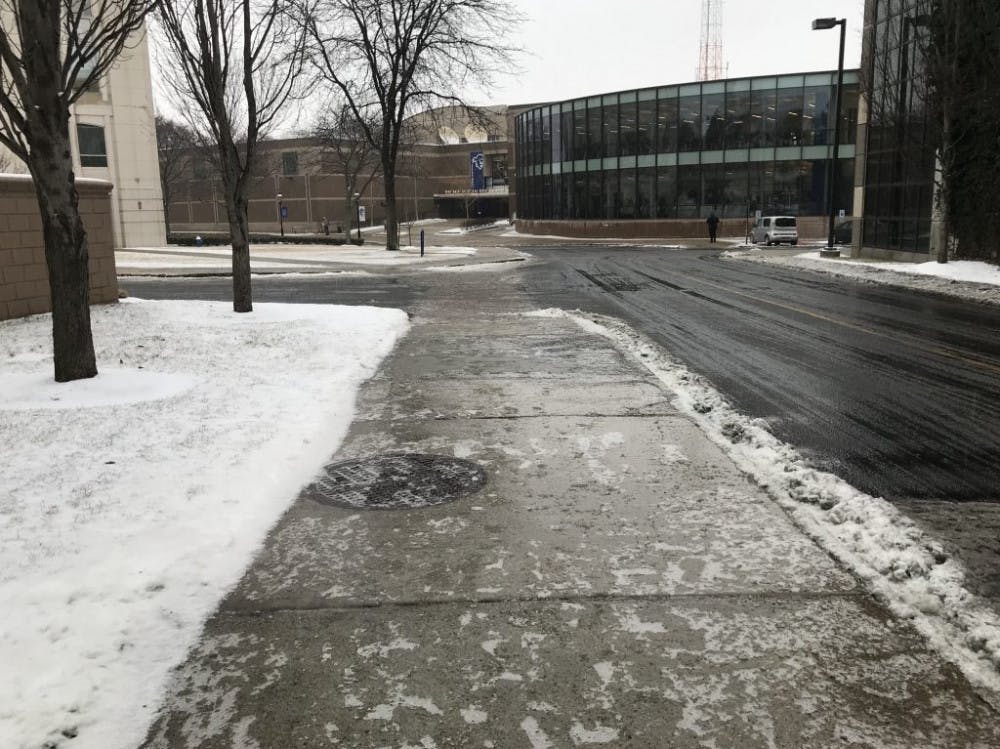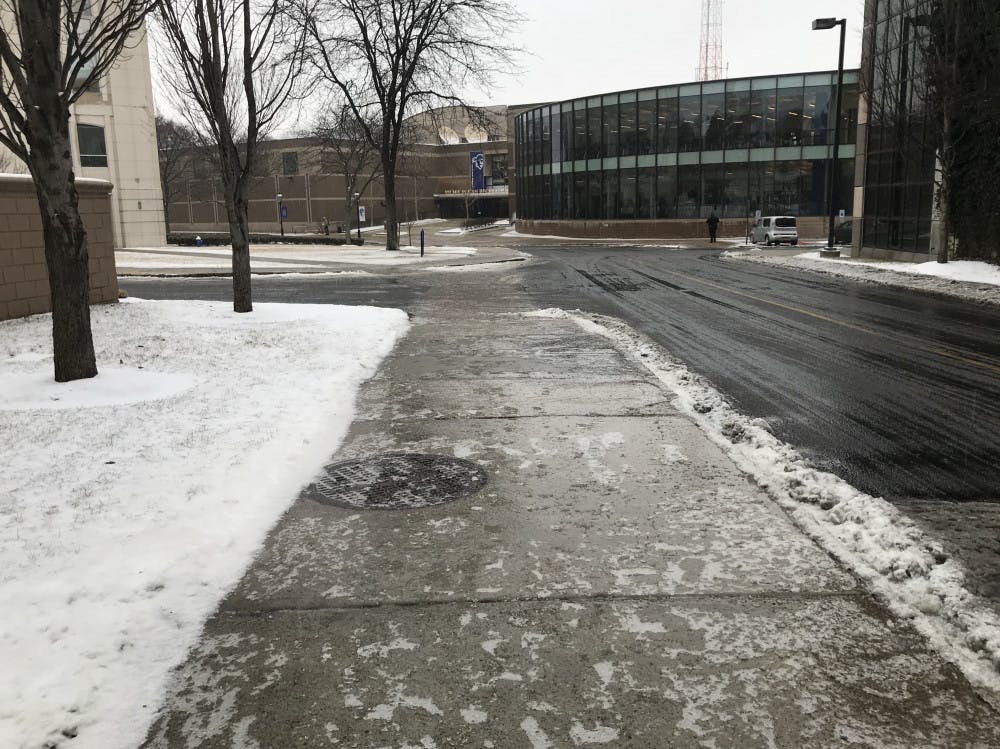The first winter storm of the season wreaked havoc across the northeast region Dec. 1 and 2, causing thousands of flight delays, hundreds of cancellations and hundreds of miles of traffic across the region during two of the busiest travel days of the year.

The bomb cyclone – dubbed Winter Storm Ezekiel by weather watchers – began as a wintry mix of rain and snow on Sunday, ultimately saturating areas of New England in more than two feet of snow by Monday. The South Orange-Maplewood area received roughly 3.5 inches of snow, according to unofficial estimates from the National Weather Service.
The response from New Jersey Governor Phil Murphy’s administration and forecasters was heightened in the run up to Monday’s snow event after an infamously botched reaction to a similar storm in Nov. 2018 that left the entire northern half of the state crippled.
Murphy was castigated by commuters and lawmakers alike in the aftermath for not preparing the roads well enough for the amount of snow that ultimately fell. The weather from that storm resulted in severe traffic along major and local roads during rush-hour, creating a political headache for the Governor’s second winter as chief executive. Murphy at the time pinned the state’s response, or lack thereof, on forecasts that he called “lousy.”
This time, Murphy’s administration was well-prepared despite the fact that some weather experts actually felt this storm was harder to forecast compared to the notorious Nov. 2018 storm.
“We’re one of the smallest states in the country with some of the most volatile weather conditions between all four seasons,” said forecaster Jonathan Carr – founder, operator and lead forecaster of the popular weather tracking website Weather NJ.
According to Carr, Monday’s storm system “drastically shifted under 12 hours from the changeover back to snow” on Monday, making it more challenging to predict than last year’s storm which was easier to see 24-48 hours out from the main event.
Regardless of the unpredictability of Monday’s snow, it was clear that the state was not taking any chances this time around with the New Jersey Department of Transportation and the New Jersey Turnpike Authority mobilizing thousands of pieces of plow equipment in advance of the storm, as well as beginning to brine the roads at the end of last week. Murphy also ordered state offices closed at 12:00 pm on Monday.
When asked about the state’s change in response to this snowstorm since the Nov. 2018 storm at a press conference on Monday, the Governor took full credit for the state’s failed response that resulted in the nightmare commute.
“That storm, putting side that it came up as a surprise, a little bit out of left field, it was a lot more intense than folks had expected – we didn’t get the job done, and that’s on me. Period,” Murphy said. “2,100 pieces of equipment, in my three winters, is about as high as we’ve been, I think. We have as much in place as we’ve had in any storm that I’ve been involved with.”
Despite the preparation, Murphy and transportation officials encouraged people to stay home from work or leave early, urging drivers to “clear the roads so we can clear the roads,”
That advice was headed by hundreds of K-12 school districts around the state who announced early dismissals or closed all together in advance of the snow dump as the National Weather Service declared winter storm warnings in several counties.
Seton Hall ultimately cancelled classed after 12:00 pm on Monday as snow began to fall earlier than initially expected in the late to mid-morning hours. The quick cancellation helped to avoid a repeat of what some said was a slipshod response on the school’s behalf during last year’s November snowstorm, in which classes were cancelled as heavy snow had already begun falling. The late call combined with the lack of treated roads stranded some students on campus and forcing longer than usual commutes for others.
“The decision to close was based on the information that NJ state government offices were closing at noon and the predictions that the evening rush hour was going to be a very difficult commute,” said Dr. Joan Guetti, Senior Associate Provost.
Guetti said that the University monitors various travel advisories and reviews weather information as it becomes available in the run-up to storm events such as this one, adding that weather conditions “can vary greatly” depending on where students and faculty are commuting from.
“Every commuter needs to make decisions on their safety when traveling in bad weather,” Guetti said. “We would also like to thank our Facilities employees who work so diligently, usually overnight, to clear and salt the sidewalks and parking lots so that we can reopen campus once the storm passes.”
The noon dismissal ultimately caused traffic on Seton Drive to back up through the parking deck as drivers all struggled to leave the campus at the same time hoping to beat the brunt of the snow, creating a chokepoint at the corner of Seton Drive and the Richie Regan Athletic Center. The traffic mostly cleared within the hour.
Montclair University also cancelled classed at 1:00 pm after initially announcing via Tweet the night before that classes for Monday would proceed as usual. Rutgers New Brunswick and Rutgers Newark soon followed suit, opting to close their universities at 3:00 pm.
The New York metropolitan area overall experienced relatively mild effects from the storm though when compared to the northwestern part of the state, which was hit with snow as high as a foot and at its peak on Tuesday had over 50,000 customers without power in Sussex, Warren, and Morris counties. At the time of publication, there were still over 28,000 customers without power, with a predominant amount of those outages in Sussex County.
On Tuesday evening, Sussex County Administrator Gregory Poff announced that the Sheriff’s Office in cooperation with the American Red Cross was opening a shelter at the Sussex Technical School to accommodate residents who were still without power.
“The Sussex County Emergency Operations Center has been activated since Sunday night, December 1 monitoring the winter storm and assisting in storm restoration with the County Divisions of Engineering and Public Works, municipal emergency management coordinators, and electric utilities,” the letter from Poff read, “The Center will remain open through the road clearing and power restoration operations.”
Winter Woes
Ezekiel forced over 15,000 flight cancellations nation-wide throughout the course of the storm as it loomed over the east coast. Seton Hall students coming back from Thanksgiving break were not spared from the travel woes with over 1,200 flights in total being delayed for several hours at Newark International Airport as sleet and snow rained down for two days.
One such student whose travel was stymied by the slushy first half of the storm was senior journalism major Payton Seda from La Habra Heights, California – a suburb of Los Angeles.
Seda’s flight from Los Angeles International Airport to Newark was delayed on Sunday as a result of the winter weather.
“Just about when were supposed to board we were told over the loudspeaker that the flight was delayed by two hours,” Seda said, adding that the staff noted the wintry mix had forced Newark to delay the opening of the runways.
“It was a little annoying to wait another two hours, especially since I had been up since 3:30am to get to the airport,” Seda said, “I was also worried that we would get delayed again, because that had happened to me before.”
Her flight did eventually board at the delayed time and landed in New Jersey around 5:30, two hours later than initially scheduled.
“I didn’t have to change any plans or make accommodations, it was more of a stress mentally than anything else,” she said.
Ryan Tonra, a senior Diplomacy and International Relations major from the greater-Boston area described a similar ordeal from the ground on Sunday as he was met with miles of traffic on his way back to South Orange, turning what is normally a four-hour trip into a six-hour ordeal.
“My commute was, in fact, terrible,” Tonra said of the drive into the belly of the storm. “I encountered bumper to bumper traffic in Massachusetts, three different times in Connecticut, and once in New York.”
Tonra noted that right as he entered Connecticut and the New York metropolitan area it was sleeting and traffic on the highway was moving at a slow crawl of 20 mph.
“Conditions were definitely dangerous,” he said, “People were skidding; there were a number of different accidents I passed along the road; a lot of police presence and I drove behind a salt truck for about a half an hour, which was unfortunate.”
Nicholas Kerr can be reached at nicholas.kerr@student.shu.edu. Find him on Twitter @NickKerr99.





